 |
||
|
||
| ||
 CONTENTS
There's little snow in the streets because it's +2 outside, and H2O can't remain solid at this temperature :). I hope that the New Year day will be more frosty, snowy and brilliant... In the very near future we will sum up the events of 2003. One of the most important events of this year is the release of the NVIDIA GeForce FX series. Theoretical materials and reviews of video cards which concern functional properties of the GPU NVIDIA GeForce FX
In the reviews listed above you can see what this GPU series is able of: from low-end to high-end models. Not all NV3x models are successful compared to the GeForce4 Ti. There are very few games which need DX9 accelerators only. Beauties of all other shader-enabled games can be well seen even with the older cards. Although they also deliver the anisotropy and AA, it's not a triumph. The situation is bettering thanks to the right price policy, though the High-End models are still pretty expensive. Today we will take a look at the new-comers from MSI, and at performance of the GeForce FX 5950/5700 in the 3DMark03. MSI is a well-known company on the world market, and the products to be tested today crown the High-End and Middle-End sectors - FX 5950 Ultra and FX 5700 Ultra. Yet in summer 2003 we decided not to use the 3DMark03 anymore because the performance could vary within 25-40% with every new patch and every new NVIDIA driver. It was unclear what results should be considered correct. Above are the links to the reviews where we investigated this issue. After all those events the benchmark left our lab. Why did we speak about it again? NVIDIA recently released drivers v5x.xx with the integrated shader compiler which optimized their execution by converting shader texts on the fly. The developers of 3DMark protested against such handling of their shaders - I must say that despite such reputation of 3DMark this benchmark is still widely used by many end-users and assemblers' testlabs. The new patch 340 released removes any shader manipulations. NVIDIA announced that it used no tricks, and the compiler was harmless, while FutureMark played a bad trick by disabling the compiler (though later they disclaimed saying that). All it happened between the official releases of NVIDIA drivers 52.16 and 53.03. After the release of the benchmark v340 the performance of all GeForce FX GPUs fell down considerably on the driver v52.16 (the patch was released right in the middle between NVIDIA's releases). What's the effect from the v53.03 where NVIDIA promised to accelerate the compiler's performance? Today we are going to answer this question. Also, we will see if the rumors saying that ATI brought optimizations into CATALYST 3.10 are true or not. Cards
The PCB design looks like the reference one, though the card is red (traditionally for MSI) and integrates proprietary coolers.
The MSI FX5950 Ultra-VTD256 video card houses a big chip, or rather the GPU in a big case with a metallic cover above: 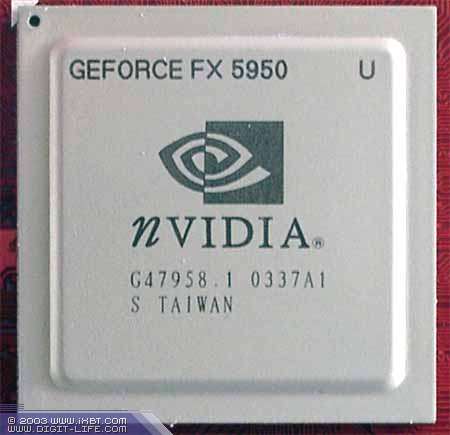 The chip is produced on the 37th week 2003, i.e. in November. The MSI FX5950 Ultra-VTD256 card is equipped with external Philips 7108 TV codec with the Video-In support. The card has the VIVO support indeed, though the TV-out is realized right in the GeForce FX5950. The MSI FX5700 Ultra-TD128 provides space for such processor. 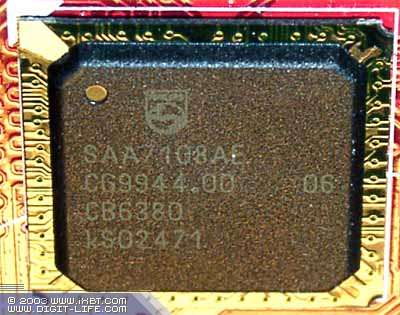 I really like beautiful things, and video cards are no exception. Look at this product: the card cheaper than $200 (or it will be cheaper very soon) looks nice in operation and better than many High-End cards with carelessly attached iron stuff instead of heatsinks.  The sink is very narrow, and the first PCI slot is not locked. 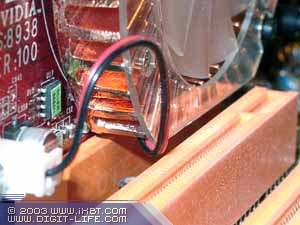 The cooler on the FX 5950 Ultra unfortunately locks this slot. Package contents. Here are the boxes the cards ship in: Testbed and driversTestbed:
VSync off, S3TC off in applications. Let's see how the FX5950 Ultra card performs in the safe overclocking mode which can be enabled in the drivers with the Auto-Detect in the toolbar. The maximum clock speeds were 516/1033 MHz (this mode almost always sets synchronous clock speeds for the chip and memory). Below you can see how the card performed at these clock rates without additional cooling in the closed PC case in this long-run test: 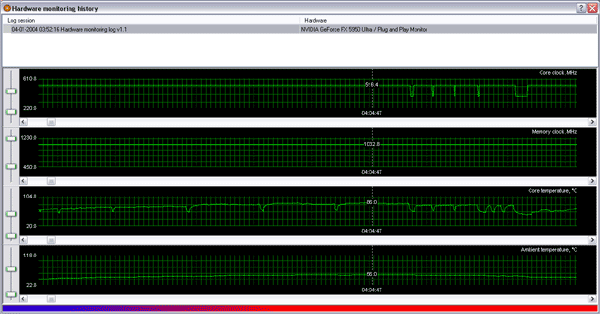 The FX 5700 Ultra card behaves pretty strangely with the driver 53.03. If the card overheats a little bit (even with the Auto-Detect) the clock speeds get reduced down to 2D default values - 300/900 MHz without a chance to get back to the 3D level - 475/900 MHz. The driver doesn't help solve it: it must be reinstalled. Test resultsBefore we start examining 2D quality, I should say there are no complete techniques for objective 2D quality estimation because:
With the ViewSonic P817 monitor and BNC Bargo cable the cards showed excellent quality at the following resolutions and clock speeds:
Test results: performanceTest application:
I do not compare quality of the cards because there are no visual
artifacts. It's not worth to compare it bit-by-bit: in the earlier
3DMark03 tests we saw that there's some difference between ATI and
NVIDIA cards because of different approaches and procedures. But there
are no artifacts, reduced detailing etc! Optimizations and tricks
are certainly used, and shaders do not work as the developers intended
them to do, but... We are well aware of NVIDIA's standpoint about
it, and it's useless to argue! We have to accept it as is whether
we like it or not. Game1
     No AA, no anisotropy: the FX5950 has a bit better scores, but this is the DX7 benchmark with complex multitexturing, where the trumps belong to NVIDIA. AA enabled: the advantage grows up. Anisotropy enabled: the situation is tougher for the 5950, and it brings parity AA and anisotropy enabled: the FX5950 marginally wins 52.16 vs. 53.03: no difference 3.9 vs. 3.10: no difference FX 5700 Ultra: No AA, no anisotropy: the FX5700U leads the pack. AA enabled: the slow memory of the R9600XT has a very negative effect on its performance which awfully falls down in 1600x1200. Anisotropy enabled: the 5700U wins in this round AA and anisotropy enabled: the same 52.16 vs. 53.03: no difference 3.9 vs. 3.10: no difference Game2
     No AA, no anisotropy: the 5950U comes out a leader (but only on the driver 53.03!) AA enabled: it wins as well (it also leads on the driver 52.16) Anisotropy enabled: the 5950 wins here (again only with the driver v53.03) AA and anisotropy enabled: NVIDIA wins again 52.16 vs. 53.03: the driver 53.03 returned NVIDIA's performance back to their level, and now we are waiting for the test developers to make another patch... 3.9 vs. 3.10: no difference! Take it into account when hearing rumors about tricks in the driver 3.10. FX 5700 Ultra: The behavior of the pair of FX5700U and R9600XT is identical to the
above one. The 5700U wins here, and the driver 3.10 has no tricks.
Game3
 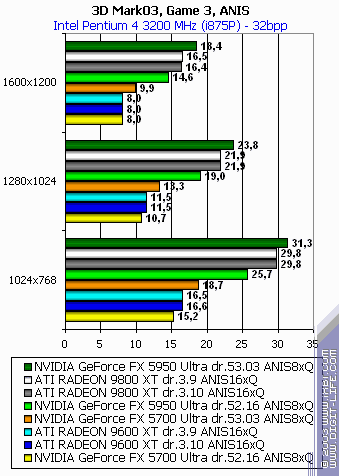 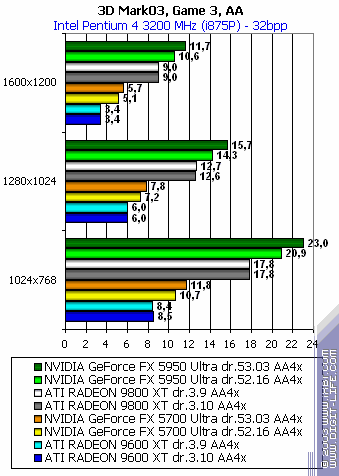 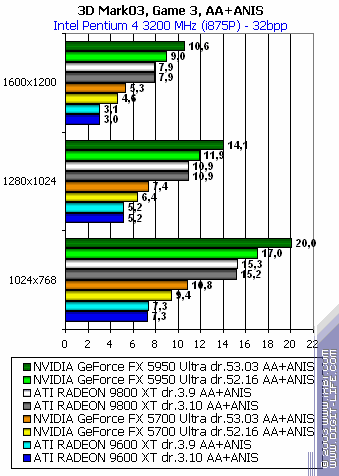 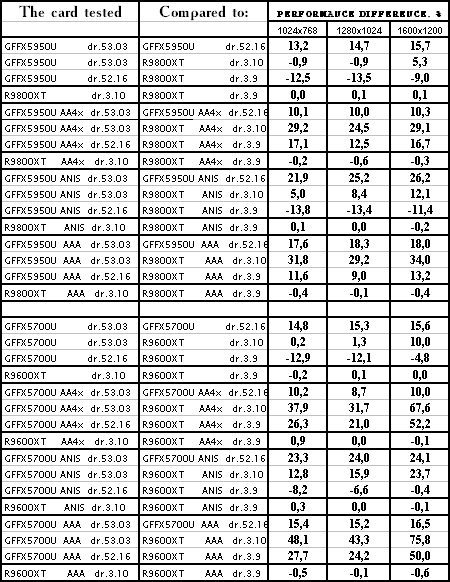 The picture looks similar: the 5950 wins this game. the driver 53.03 lifts up its speed, and it's time for the developers of 3DMark03 to take another step. But I'm sure a new driver will bring it back again.. Where is a way-out? - There's none. FX 5700 Ultra: Game4
   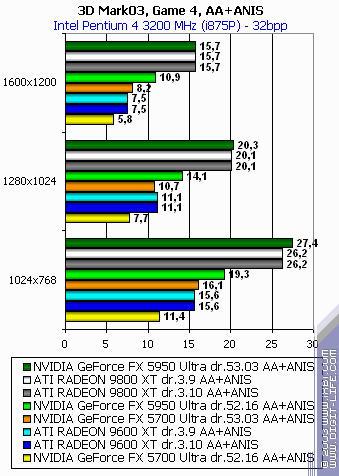 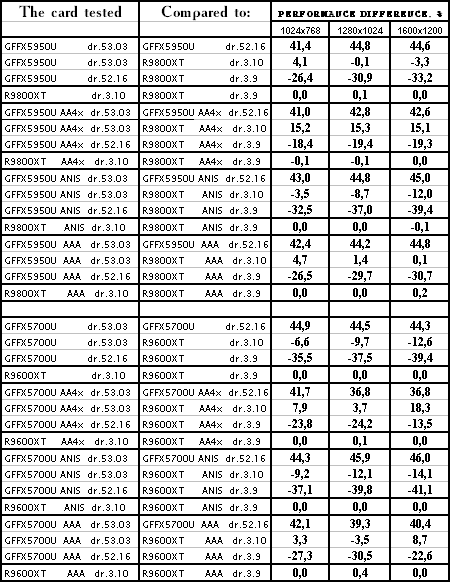 No AA, no anisotropy: the card goes on a par with the 9800XT (the driver 52.16 helped it gain a good advantage!) AA enabled: while the driver 53.03 made the 5950 a good winner, the driver 52.16 makes it a good loser Anisotropy enabled: the 5950U lost the battle AA and anisotropy enabled: the driver 53.03 brings equal scores (with the driver 52.16 the game was lost) 52.16 vs. 53.03: the optimizations are back, the NVIDIA cards gained some performance. 3.9 vs. 3.10: no difference. FX 5700 Ultra: No AA, no anisotropy: the card loses in spite of all attempts of the driver 53.03 make the 5700U a winner. AA enabled: here this driver saves its ward Anisotropy enabled: the defeat again! AA and anisotropy enabled: parity on the driver 53.03, and victory on the driver 52.16 52.16 vs. 53.03: the evident optimizations do not let the developers of 3DMark03, as well as ATI, sleep well :-) ). MARKS
 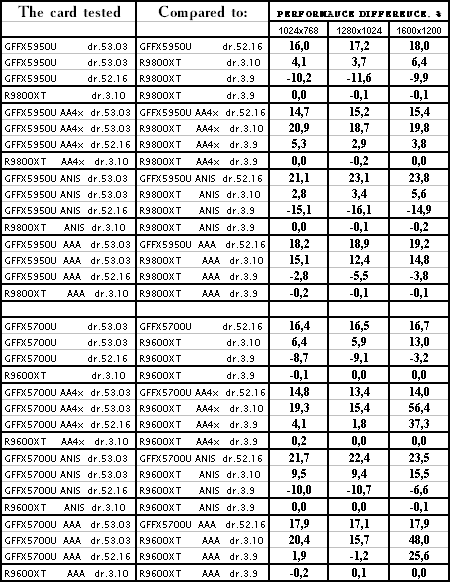 The FX 5950 Ultra beats the competitor on the driver 53.03. 52.16 vs. 53.03: 18% lost after the patch 3.40 are brought back by the new driver. 3.9 vs. 3.10: the rumors that the 3.10 uses tricks are found to be wrong. But taking into account NVIDIA's optimizations ATI has a right for them to. However, they mentioned in forums that they've already got a compiler like that of NVIDIA. FX 5700 Ultra: The driver 53.03 helps the card outdo the RADEON 9600 XT. 52.16 vs. 53.03 and 3.9 vs. 3.10: the same situation.
Vertex Shaders
  The card catches up with the 9800XT, though it's mostly due to the optimizations in the driver 53.03. 52.16 vs. 53.03: the performance is lifted up by 30%. 3.9 vs. 3.10: no difference FX 5700 Ultra: Here's the promised difference between the 5700 and 5600! Look at the performance of the 5950 and 5700U! The cards have the same number of vertex pipelines and equal clock rates of 475 MHz... Hence the parity. It lets the card easily beat the R9600XT. 52.16 vs. 53.03: the optimizations increase the performance by a quarter. Pixel Shaders
 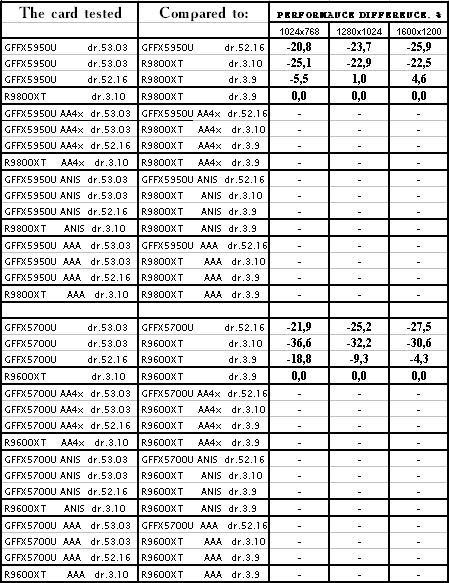 The driver 53.03 cuts off the performance by 20-25%, though earlier the cards had almost equal scores even with the patch 340. Did they remove the optimizations? Did they bring back the shader correlation we saw earlier in some tests? Strange. 3.9 vs. 3.10: nothing. FX 5700 Ultra: The picture is the same; the defeat has worsened. Conclusion
Regarding the 3DMark03, I must say that it doesn't make sense to compare the cards' quality because optimizations NVIDIA and ATI make are unnoticeable. Besides, we don't have a standard of quality: it's actually a matter s taste whether a leaf is turned to the right or left. NVIDIA and 3DMark03 play an endless game. The patch 340 cut the speed of all GeForce FX GPUs, and the driver 53.03 brought it back to its previous level. The driver is WHQL certified, and FutureMark can't forbid them using these results. Should we expect the patch 350? What's next? The testlabs' work is going to become useless, right? NVIDIA doesn't keep in secret their optimizations. You can blame them, buy only RADEONs, protest, keep silence or favor them. We said that it's good to use optimizations in games but not in benchmarks because the comparison becomes unequal. But that won't change anything! Our previous protests against the tricks are unfortunately unsupported by anyone :-( Who will be the first to lose their authority: the trick makers or the developers of 3DMark03? It's hard to say. But we can see that it's impossible to trust 3DMark in such situation. However, there are no alternatives yet. As to ATI's drivers, the versions 3.9 and 3.10 have no difference. The rumors that the v3.10 got optimizations are wrong. In our 3Digest you can find
full comparison characteristics for video cards of this and other
classes.
Andrey Vorobiev (anvakams@ixbt.com)
Write a comment below. No registration needed!
|
Platform · Video · Multimedia · Mobile · Other || About us & Privacy policy · Twitter · Facebook Copyright © Byrds Research & Publishing, Ltd., 1997–2011. All rights reserved. | |||||||||||||||||||||||||||||||||||||||||||||||||||||||||||||||||||||||||||||||||||